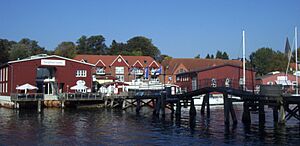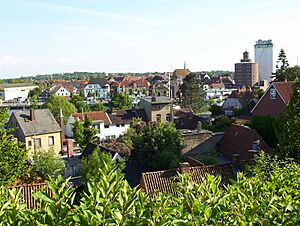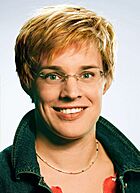Eckernförde facts for kids
Quick facts for kids
Eckernförde
|
||
|---|---|---|

Port of Eckernförde in mid-October 2005
|
||
|
||
| Country | Germany | |
| State | Schleswig-Holstein | |
| District | Rendsburg-Eckernförde | |
| Elevation | 21 m (69 ft) | |
| Population
(2022-12-31)
|
||
| • Total | 21,507 | |
| Time zone | CET/CEST (UTC+1/+2) | |
| Postal codes |
24340
|
|
| Dialling codes | 04351 | |
| Vehicle registration | ECK | |
Eckernförde is a city in northern Germany. It is located in the Rendsburg-Eckernförde area of Schleswig-Holstein. The city sits right on the coast of the Baltic Sea. About 23,000 people live there. Eckernförde is a popular place for tourists to visit. It is about 30 kilometers (18 miles) north-west of Kiel.
Contents
What Does the Name Eckernförde Mean?
The name Eckernförde has a mixed history. It comes from an old Danish castle that used to be near the town. This castle's name is also seen in the town district called Borby. In the 1200s, the castle was known as Ykærnæburgh. Later, in 1441, the town's official seal showed the name Eherneborgh.
The first part of the name, "Eckern", comes from the modern Danish word "egern". This word means squirrel. The second part, "-förde", is a Low German word for fjord. A fjord is a long, narrow inlet of the sea. Because of this, you can see a squirrel on the town's coat of arms. This squirrel has been on the town's seal since 1441!
A Look Back at Eckernförde's History
- In 1197, Eckernförde was first mentioned in writing.
- It was officially called a city for the first time in 1302. However, people living there were already called "city citizens" in 1288.
- In 1628, the city was taken by Christian IV of Denmark. This happened during a conflict with troops from the Holy Roman Empire.
- In April 1849, during the First War of Schleswig, two Danish ships tried to land in Eckernförde. They were fired upon from the shore. One ship, the Christian VIII, exploded. The other ship, the Gefion, gave up and was captured.
- On November 13, 1872, a huge flood hit the Baltic Sea coast. Eckernförde was hit the hardest because of its location on Eckernförde Bay. The whole town was flooded. 78 houses were destroyed, and 138 were damaged. Many families lost their homes.
- The famous Count Saint-Germain was buried near St. Nicolai Church in Eckernförde. Sadly, his grave was destroyed by the 1872 flood.
- In 1934, the nearby seaside town of Borby became part of Eckernförde.
- After Second World War, a special camp for people from Estonia was set up near Eckernförde. It helped people who had been forced to leave their homes.
What Eckernförde is Known For
In the early 1900s, Eckernförde was known for its busy harbor and fishing. People also traded farm products there. The city made salt and iron goods.
Today, all German Navy submarines are based in Eckernförde. They are part of the 1st Ubootgeschwader. Eckernförde is also home to BEHN, a family company that makes drinks. It was started way back in 1792. The main office of SIG Sauer, a company known for making firearms, is also located here.
Schools in Eckernförde
Eckernförde has many schools for students of all ages. Here are some of them:
- Richard-Vosgerau-Schule: This is a public elementary school. It has a main building, a smaller building, a football field, and a sports hall. Kids can also enjoy slides and climbing in the schoolyard.
- Fritz-Reuter-Schule: This school teaches both primary and regional school students.
- Waldorf School: A school that uses a special teaching method.
- Gudewerdt Schule: Another primary and community school.
- Pestalozzi Schule: A special school for students with unique learning needs.
- Schule am Noor: Also a special school.
- Jungmannschule: This is a high school.
- Peter-Ustinov-Schule: A community school.
- Sprottenschule: Another primary school.
- Jes Kruse Skole: A private Danish school.
Getting Around Eckernförde
The Kiel–Flensburg railway runs through Eckernförde. Trains stop at Eckernförde station, which is west of the town center. The main bus station, called the central omnibus station (or ZOB), is right next to the train station.
The company that runs the trains is Deutsche Bahn. Eckernförde has four bus routes for getting around the city. These buses are single-deck. There are no trams or trolley-buses. You can use the statewide Schleswig-Holstein-fare for transportation.
If you need a taxi, there's a taxi stand at the bus station. Eckernförde also has two places where you can rent bikes. One is near the beach, and the other is in the main walking area.
The closest international airport is Hamburg Airport.
Eckernförde's Sister Cities
Eckernförde has special friendships with other cities around the world. These are called twin towns or sister cities:
 Bützow, Germany (since 1990)
Bützow, Germany (since 1990) Hässleholm, Sweden (since 1958)
Hässleholm, Sweden (since 1958) Tanga, Tanzania (since 1963)
Tanga, Tanzania (since 1963)
Famous People from Eckernförde
Many interesting people have connections to Eckernförde:
- Count of St. Germain (died 1784): A mysterious aristocrat and adventurer.
- Georg Gerlach (1797–1865): A Danish officer.
- Lorenz von Stein (1815–1890): An important thinker in economics and sociology.
- Karl Wilhelm Valentiner (1845–1931): A famous astronomer.
- Frederick G. Clausen (1856–1940): A German-American architect.
- Walter von Bülow-Bothkamp (1894–1918): A brave fighter pilot in World War I.
- Ruth Halbsguth (1916–2003): A swimmer who won a silver medal at the 1936 Summer Olympics.
- Inge Viett (born 1944): A former member of a political group.
- Christoph, Prince of Schleswig-Holstein (born 1949): The head of the House of Glücksburg royal family since 1980.
- Horst-Dieter Kolletschke (born 1952): A retired rear admiral in the German Navy.
- Grietje Staffelt (born 1975): A politician who was a member of the German parliament.
- Ingmar Zahorsky (born 1983): A photojournalist and media artist.
- Michael Schulte (born 1990): A popular singer and songwriter.
See also
 In Spanish: Eckernförde para niños
In Spanish: Eckernförde para niños





